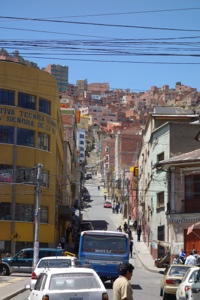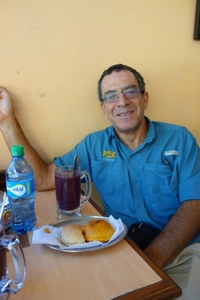After 45 minutes of anxiety when my flight was delayed on the ground in SF, I made my connection and arrived in La Paz on schedule at 5:15 this morning after a seven hour flight from Miami. I thought I hadn’t slept at all, but I must have because A) I was not awake for seven hours, and B) I felt pretty good when I got here. Alissa picked me up at the airport in a cab. The airport is at 13,500 feet, and the city center is at 12,000, and so we descended into the city through the parade of brown brick houses gradually lit by the early morning sunrise.
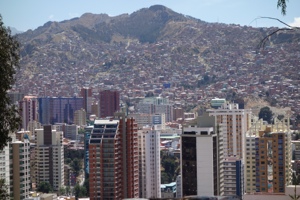
Downtown La Paz with the neighborhoods rising up the hills above it.
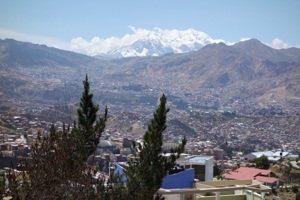
Mount Ilimani towering over La Paz
After a couple hours rest, Alissa came and spent the day walking my legs off. The city center is concentrated in a valley, with the main street at the bottom of the valley and the city rising up on both sides. Some areas really reminded both of us of SF neighborhoods like Russian Hill. If you walk crosstown you are going up hill or down hill; walking parallel to the valley floor you traverse the neighborhood you are in on the terraced roadways. We did a lot of both!
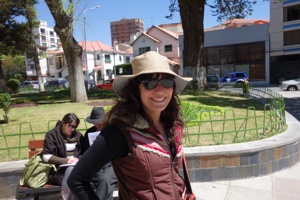
My buoyant, joyful hostess in another photo with sunglasses.
Alissa walked me through most of the neighborhoods of the center area. La Paz is a mishmash of architectural style and building function. Highrises are tucked in next to private homes, schools next to auto shops, business headquarters buildings in otherwise residential areas. A colonial house sits next to a modern one. I’m getting a personal tour of everything Alissa likes about La Paz. We went to her favorite cafe for breakfast, then walked up the hill to a park with a stunning perspective of the city. After a detour to the tourist area to do a little gift shopping we headed over to the older part of town where grand colonial buildings clashed with nondescript office and residential buildings in the very next block. A long walk down the main street led to the Plaza de estudiente, where the university and several lower schools had set shop. The street was packed; students of all sizes in uniforms, indigenous women in native dress, young men and women smartly dressed in business clothing, locals in more casual clothing, but everyone enjoying their two hour lunch in the warmth of a Bolivian springtime. Although some people look Castilian and some purely native, the majority of Bolivians are mestizo. Sixty percent of the population is identified as indigenous, members of the 36 autonomous groups that make up the native population.
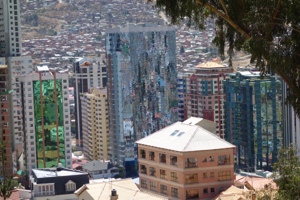
Glass sided highrise reflecting the residential neighborhood below it.
Just like home; a steep stair lined street under construction.
A stop at the friendly neighborhood snack shop led to a typical lunch: empanadas and api, that thick purple drink in the photo, made of ground purple corn, cinnamon, fruit juice and sugar.
After lunch we were off to the folklore museum, small but very well curated, with the most wonderful collection of ceremonial masks from all over the country. Some looked Chinese. some looked Balinese. some looked African. Couldn’t take photos there, but the strong sense of and pride in their history really showed. Through her research, Alissa knows quite a bit about how Bolivian society is structured and she had answers to a lot of my questions. Bolivia is taking care of its people; it’s left wing government neither corrupt or megalomaniacal. How refreshing!
Tonight we are off to the Hotel Rosario (for what Alissa assures me will be a great dinner) with her friend Rita, a Finn who is studying political science and economics, so I expect to learn more about that. Early tomorrow we are off to Lake Titicaca for two days, touring Copacabana, Inca and pre-Inca sites, and getting in some hiking.
Thanks for reading.

